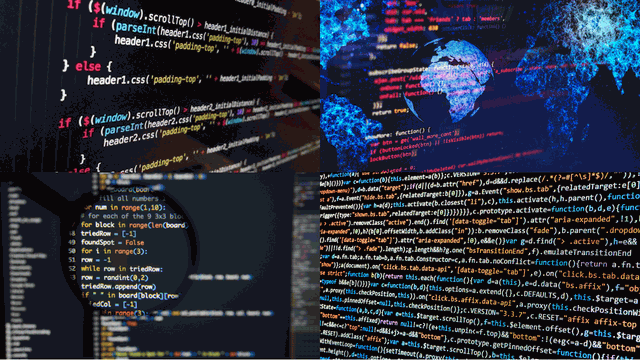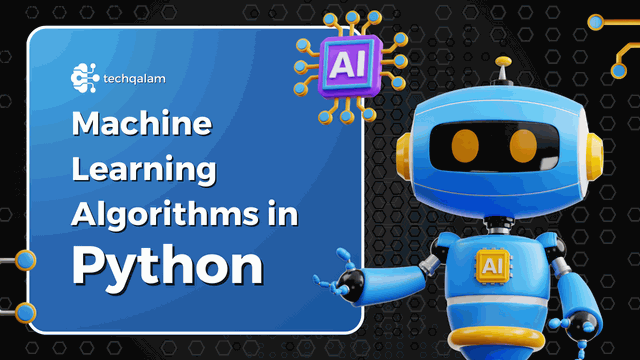Machine Learning Algorithms in Python: A Comprehensive Guide
Preface
It’s an AI application that lets machines learn for themselves. When the input data changes, machine learning algorithms—which combine logic and arithmetic—adapt to perform quickly.
Python is a general-purpose language that is simple to learn and understand, making it useful for a variety of development jobs.

Because Python can perform a huge number of machine learning tasks, most algorithms are developed in this language. With the aid of a Python for Machine Learning course, you may upgrade your expertise and establish strong skills in machine learning.
The training and testing phases make up the two stages of the creation of machine learning algorithms. Supervised learning, unsupervised learning, and reinforcement learning are the three categories into which machine learning algorithms fall, despite their large number of variations.
“The top two most popular Python machine learning algorithms from the first two categories will be covered in this edition”.
♦ Machine Learning Algorithms
Machine learning algorithms enable machines and systems to learn and improve their own intelligence and performance. Machine learning algorithms are mathematical and logical programs that improve themselves by learning from new data.
Machine learning algorithms lay the groundwork and structure for a machine or system. Machine learning algorithms are the brains behind many automated systems and AI integrations.
Algorithms written in mathematical notation have analogs in most programming languages.
Similarly, machine learning algorithms can be used with many different structures and programming languages. However, there are some programming languages that are better suited to ML and ML tasks.
♦ Machine Learning Algorithms Category
Machine learning algorithms fall into two categories.
Ω Supervised Learning Algorithms
The variables, together with input and output variables, are used by these techniques to aid in solving practical machine learning problems.
These algorithms help systems learn to distinguish between different outputs from the provided dataset and an output that has already been delivered.
They help systems improve their ability to map the function by utilizing the output as a guide, resulting in more accurate predictions of the output over time.
The machine has proven successful when it can replicate the desired result when left to its own devices.
Ω Unsupervised Learning Algorithms
Since there are no output variables provided, these algorithms only need input variables. By modeling the data structure, these methods assist the machines in learning from the dataset independently without human supervision.
In addition to being programmed to tackle association and clustering problems, these computers are tasked with extracting information from the provided datasets.
♦ Which are the top machine learning algorithms in Python?
Ω KNN, or K-nearest Neighbors
In order to classify the data points, it can analyze the labels of the given data points that surround the target data points and create predictions.
KNN is applied to jobs involving both classification and regression. It’s a supervised learning system that finds anomalies, mines data, and recognizes patterns.

Ω SVMs, or support vector machines
It uses vector computing to efficiently optimize this differential line after differentiating the different categories in the dataset. This supervised machine learning approach aids in data analysis for issues with regression and classification.
Ω Discreet Hopfield Network
It contributes to the development of artificial neural networks, which are capable of storing and retrieving data from incomplete input.
Machines can perform a recurrent behavior known as auto-associative learning thanks to this technique.
Ω Back-propagation
By adjusting the weights of the input signals, this algorithm may create the necessary output signals by designing the specified functions.
This algorithm for supervised learning is applied to regression and classification. Through the use of the delta rule approach or gradient descent, back-propagation determines the lowest values of error functions.
The method determines the necessary weights in this way in order to minimize or neutralize error functions.

Ω XGBoost
It is a gradient-boosting technique that may be applied to a number of tasks, including classification, ranking, and regression. This includes both the linear model and the tree learning technique, enabling XGBoost to make highly accurate event predictions.
In comparison, this process is roughly ten times quicker than earlier gradient-boosting methods.
Ω Hierarchical Clustering
This algorithm employs a cluster analysis methodology. It functions by first creating a cluster tree to represent the data, then grouping related objects into what are known as clusters.
Each of these groups, sometimes called nodes, receives data that is comparable in kind and is connected to two or more successor groups.
Ω Random Forest
It essentially functions as an ensemble learning technique for issues involving classification, regression, and other processes by constructing a collection of several decision trees throughout the training phase.
Based on qualities, Random Forest assigns a class to each decision tree in order to classify things. The class that reports the most trees is then selected using this algorithm.

♦ Apriori Machine Learning Algorithm
This algorithm is used to sort enormous volumes of data; it is a categorization algorithm. This technique can be used to create association rules based on a dataset, and it can also be used to monitor the evolution of item sets in order to create categories.
It is an unsupervised machine learning method that can be used for process auto-completion and event prediction.
Conclusion
There are a multitude of machine learning algorithms that facilitate the construction of machines and systems by developers and data scientists.
These technologies enable organizations and corporations to achieve diverse IT, business, and statistical objectives. When selecting an appropriate machine learning algorithm.
It is essential to take into account the working environment and both the present and future project requirements.
FAQs
⊕ How numerous are machine learning algorithms?
Machine learning algorithms are broadly classified into four groups. There are four types of learning algorithms: supervised learning algorithms, unsupervised learning algorithms, semi-supervised learning algorithms, and reinforcement learning algorithms.
⊕ How do I know which machine learning algorithm to use?
This can only be discovered by examining the project’s scope. This is determined by a variety of elements, including the variables and values with which one will be working, the values or information that must be discovered, and, most importantly, the complexity of the learning needs
The type of algorithm required is also strongly dependent on the dataset or training data available and its quality, which necessitates noise removal, additional processing, pre-processing, or data mining.
⊕ Which machine learning algorithm is the most effective in Python?
Linear regression is the best ML algorithm in Python since it is widely used for ML and is recommended by many ML developers. This supervised ML approach is well-known and praised for its ability to predict outcomes while watching features.
It can run on a single variable or several variables. It is also less complicated and easier to apply, which is why it is favored by many beginners.
⊕ What additional languages are utilized in machine learning?
Despite the fact that Python is best suited for machine learning, many developers opt to power numerous machine learning projects with languages including R, Java, and Julia. R is specifically famous for being very statistically oriented and capable of solving statistical issues very successfully.
⊕ When do we expect machine learning to reach its full potential?
ML has a bright future ahead of it as technology and AI improve on a daily basis. ML has a bright future, with tremendous innovations being made in a variety of industries that use machine learning as a basis for addressing challenges, tackling issues, and powering automation.
Get access all prompts: https://bitly.com/um4ty







